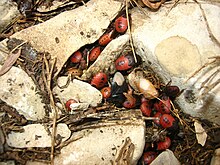Cydnus aterrimus
| Cydnus aterrimus | ||||||||||||
|---|---|---|---|---|---|---|---|---|---|---|---|---|

Cydnus aterrimus |
||||||||||||
| Systematics | ||||||||||||
|
||||||||||||
| Scientific name | ||||||||||||
| Cydnus aterrimus | ||||||||||||
| ( Forster , 1771) |
Cydnus aterrimus is a bug from the family of earth bugs (Cydnidae).
features
The bugs are 8.0 to 12.0 millimeters long, making them the largest members of their family in Central Europe. They have a black colored, densely punctured body. The membranes of the hemielytres are milky white, the corium is wavy at the rear edge , unlike in similar species. The nymphs have a red-colored abdomen.
distribution and habitat
The species is widespread in the Palearctic , in the Afrotropic and in the Indo-Australian area. In Europe it is absent in the north and in the British Isles. In Germany it occurs everywhere, with the exception of the northwest German lowlands. It is also widespread throughout Austria, but only occurs more frequently in central Europe in some places. Mostly sandy or chalky, dry habitats are settled.
Way of life
Cydnus aterrimus lives on milkweed ( Euphorbia ). In Central Europe it is often found on cypress spurge ( Euphorbia cyparissias ). They dig a few centimeters deep into the ground and suckle at the roots of their host plants. Older nymphs and adult bugs also suckle on the aboveground parts of the plants, especially the ovules. They can be found sitting on the inflorescences, especially during the mating season and at high temperatures. The eggs are laid underground. The females guard their clutches, which consist of 30 to 65 eggs, and also the nymphs until the second molt. The young nymphs suck on secretion droplets that the females secrete from the anus in order to ingest endosymbiotic microorganisms. The nymphs live in aggregations that are sometimes sustained into the fourth nymph stage. Then they disperse. The overwintering occurs as an adult bug in the ground. In spring, the animals appear and mate from April or May. The adult animals of the new generation can be observed from the end of July or August.
supporting documents
Individual evidence
- ^ A b c Ekkehard Wachmann , Albert Melber, Jürgen Deckert: Bugs. Volume 4: Pentatomomorpha II: Pentatomoidea: Cydnidae, Thyreocoridae, Plataspidae, Acanthosomatidae, Scutelleridae, Pentatomidae. (= The animal world of Germany and the adjacent parts of the sea according to their characteristics and their way of life . 81st part). Goecke & Evers, Keltern 2008, ISBN 978-3-937783-36-9 , pp. 10 .
- ↑ Ekkehard Wachmann : Observe bugs - get to know . Neumann-Neudamm, Melsungen 1989, ISBN 3-7888-0554-4 , p. 76 .
- ↑ Frieder Sauer: Sauer's nature guide recognized bugs and cicadas from color photos . Fauna, Keltern 1996, ISBN 3-923010-12-5 , p. 36 .
literature
- Frieder Sauer: Sauer's nature guide recognized bugs and cicadas from color photos . Fauna, Keltern 1996, ISBN 3-923010-12-5 .
- Ekkehard Wachmann : watch bugs - get to know . Neumann-Neudamm, Melsungen 1989, ISBN 3-7888-0554-4 .
- Ekkehard Wachmann , Albert Melber, Jürgen Deckert: Bugs. Volume 4: Pentatomomorpha II: Pentatomoidea: Cydnidae, Thyreocoridae, Plataspidae, Acanthosomatidae, Scutelleridae, Pentatomidae. (= The animal world of Germany and the adjacent parts of the sea according to their characteristics and their way of life . 81st part). Goecke & Evers, Keltern 2008, ISBN 978-3-937783-36-9 .
Web links
- Cydnus aterrimus at Fauna Europaea. Retrieved June 16, 2015
